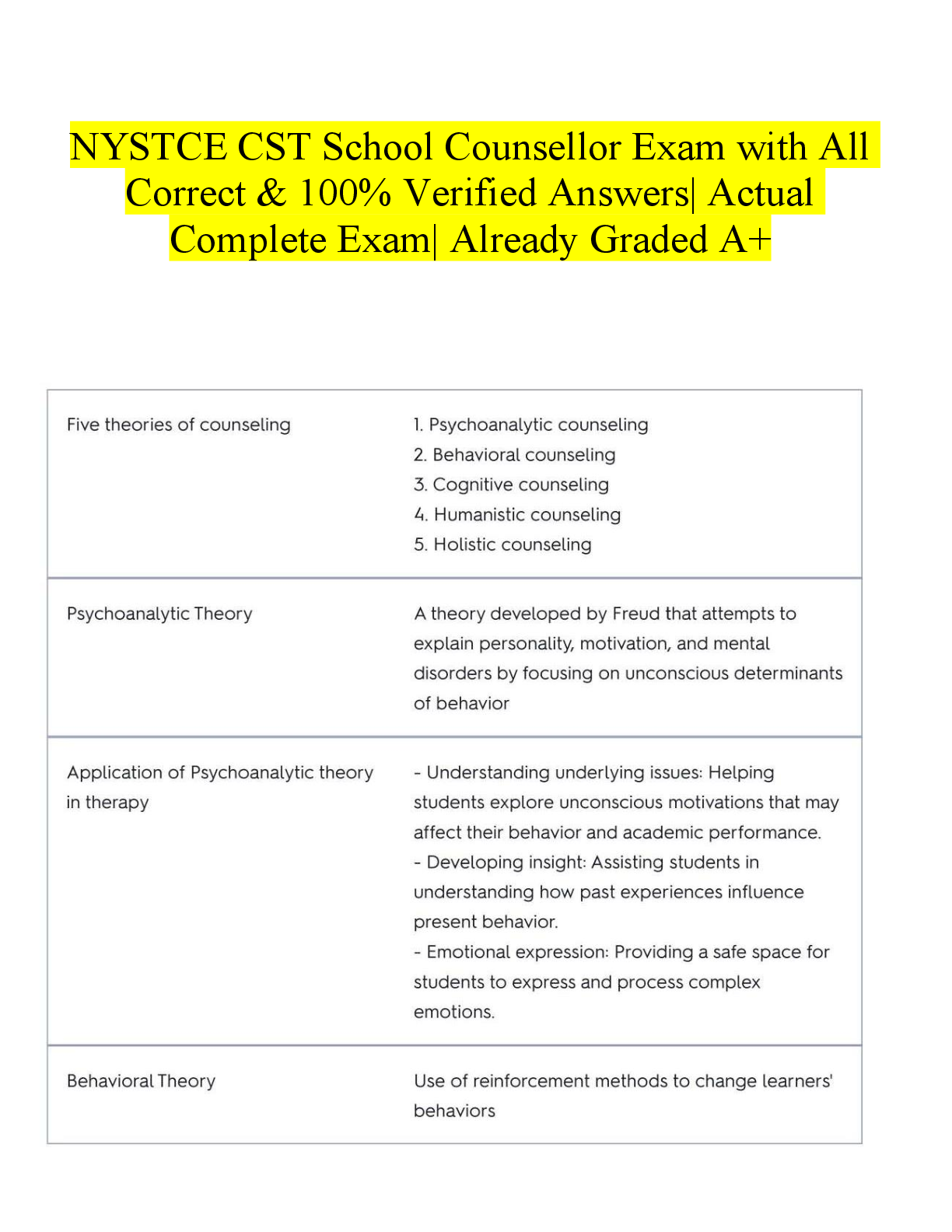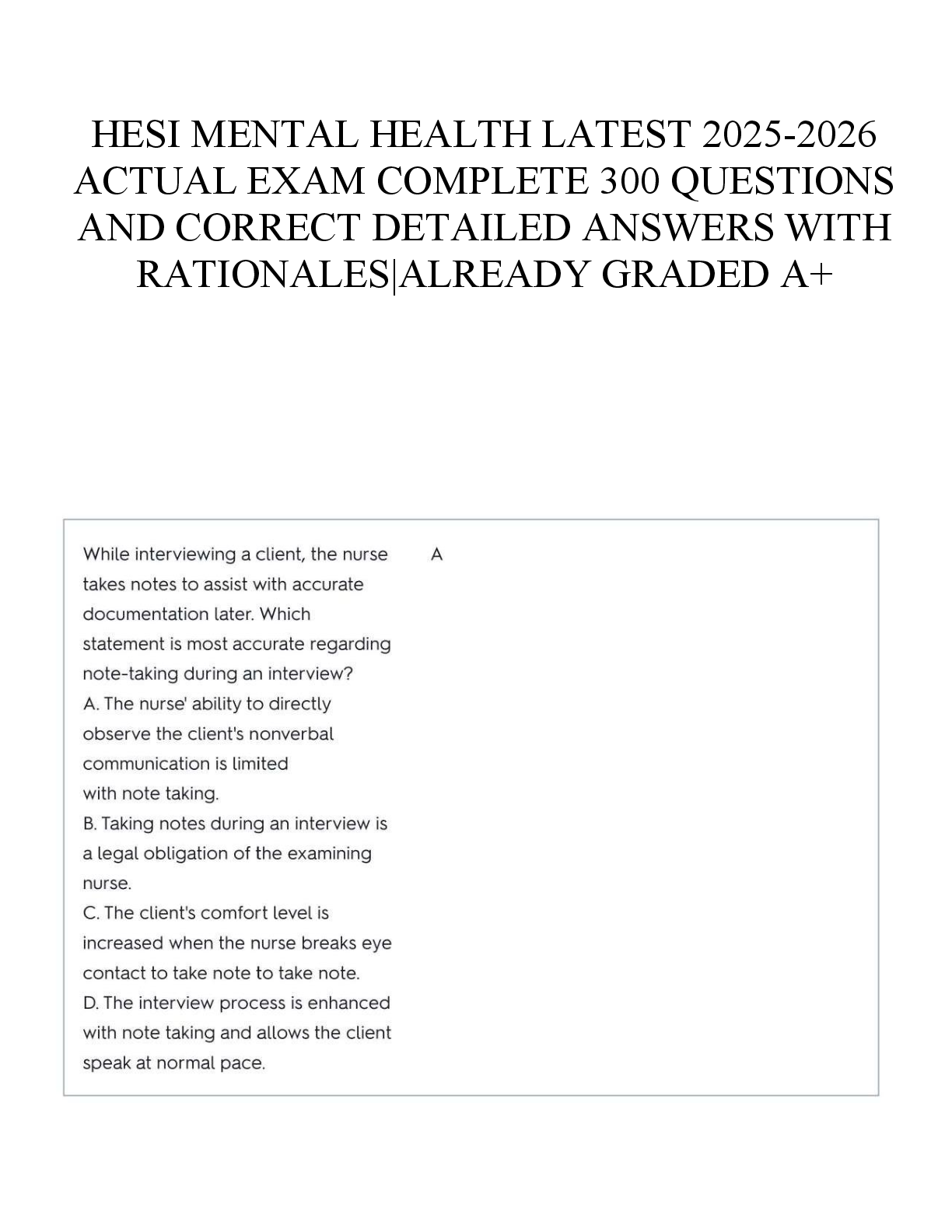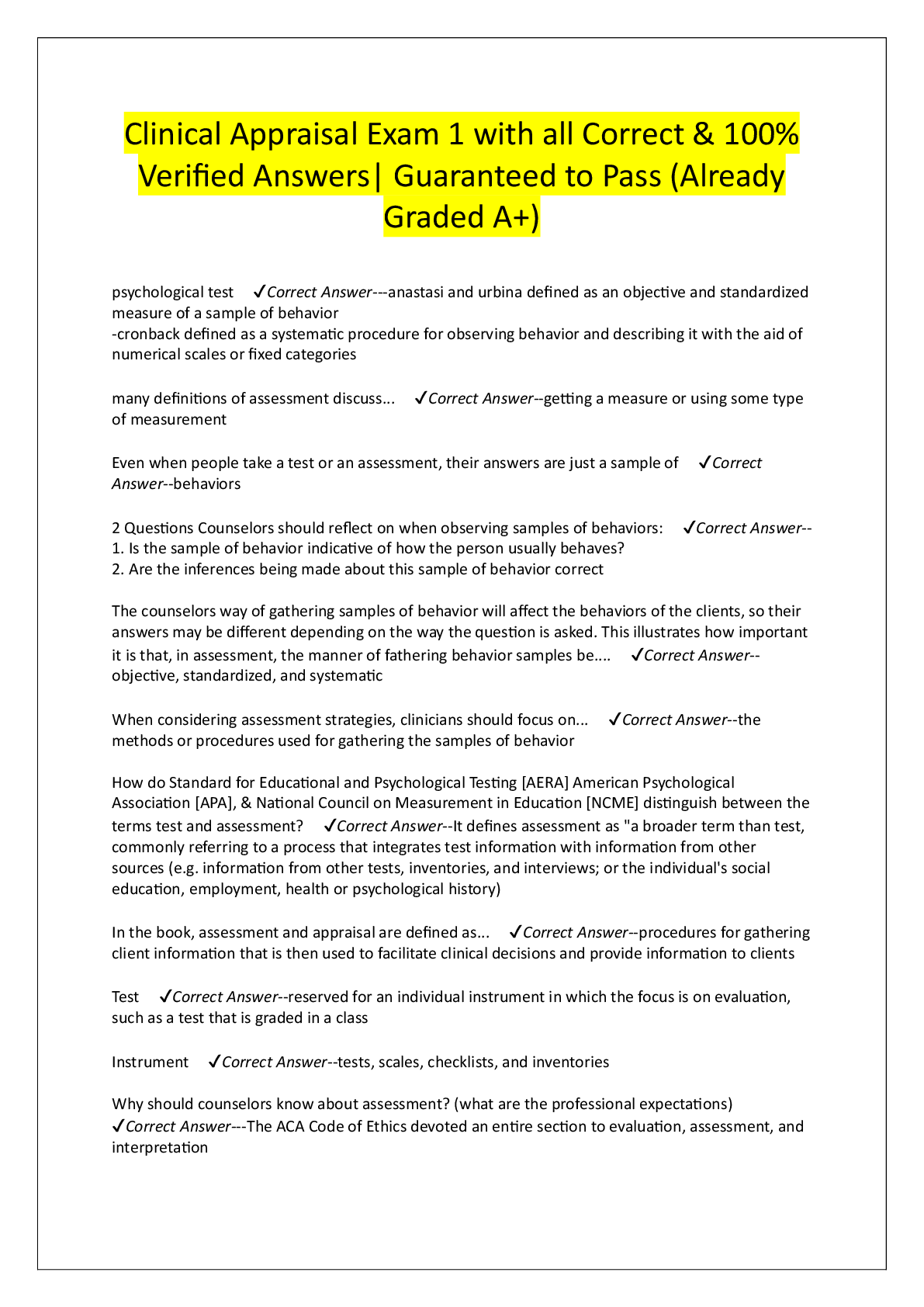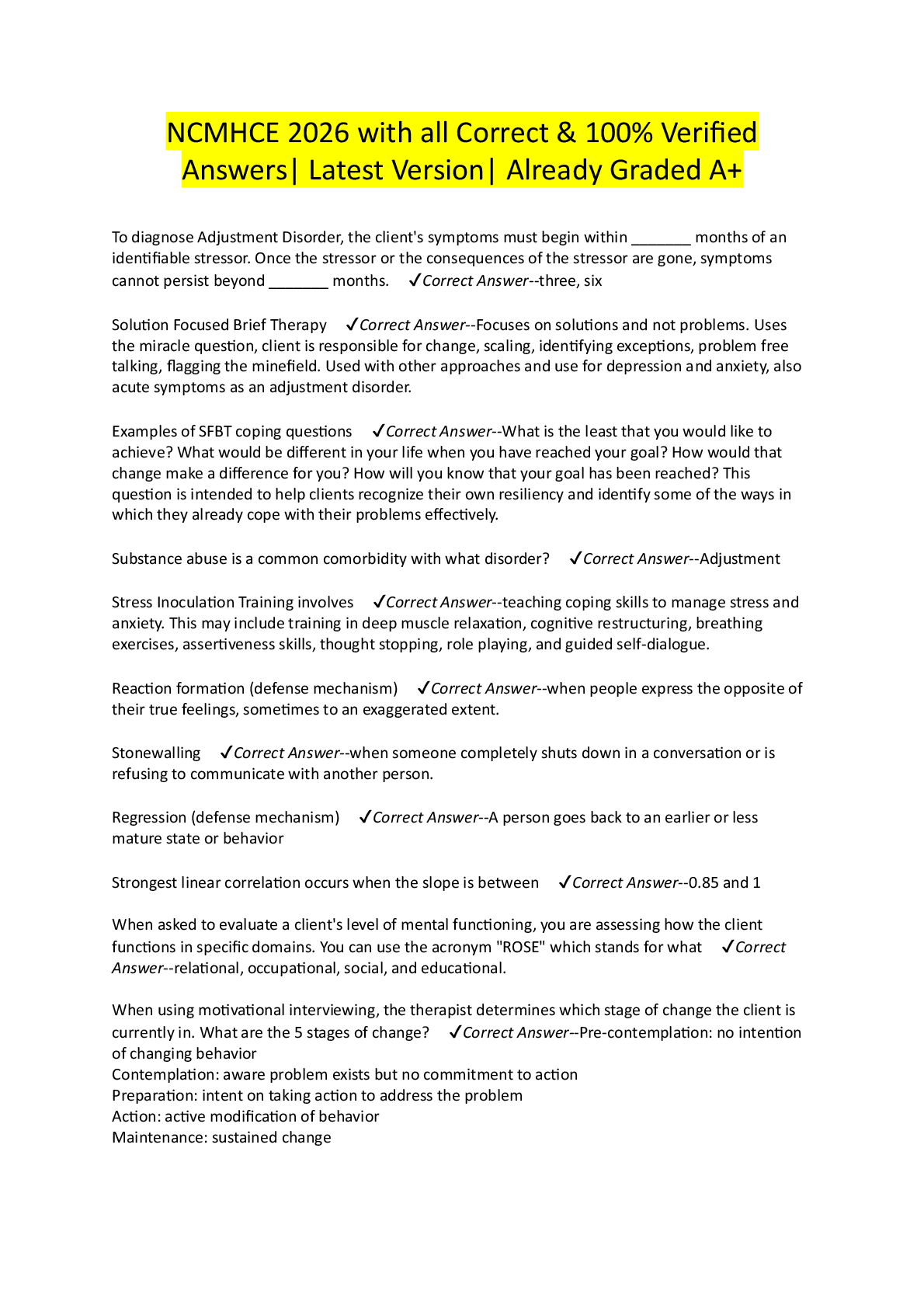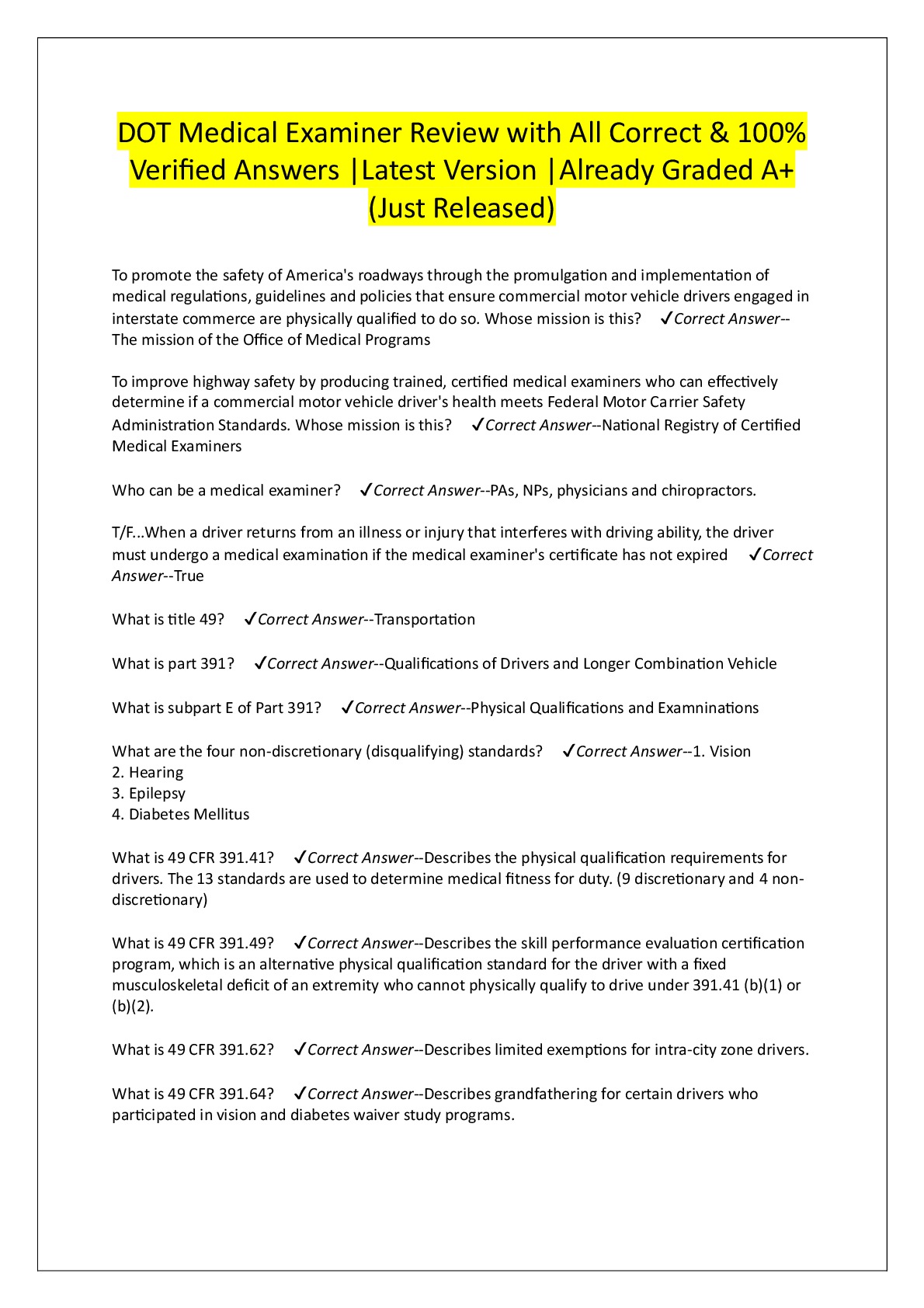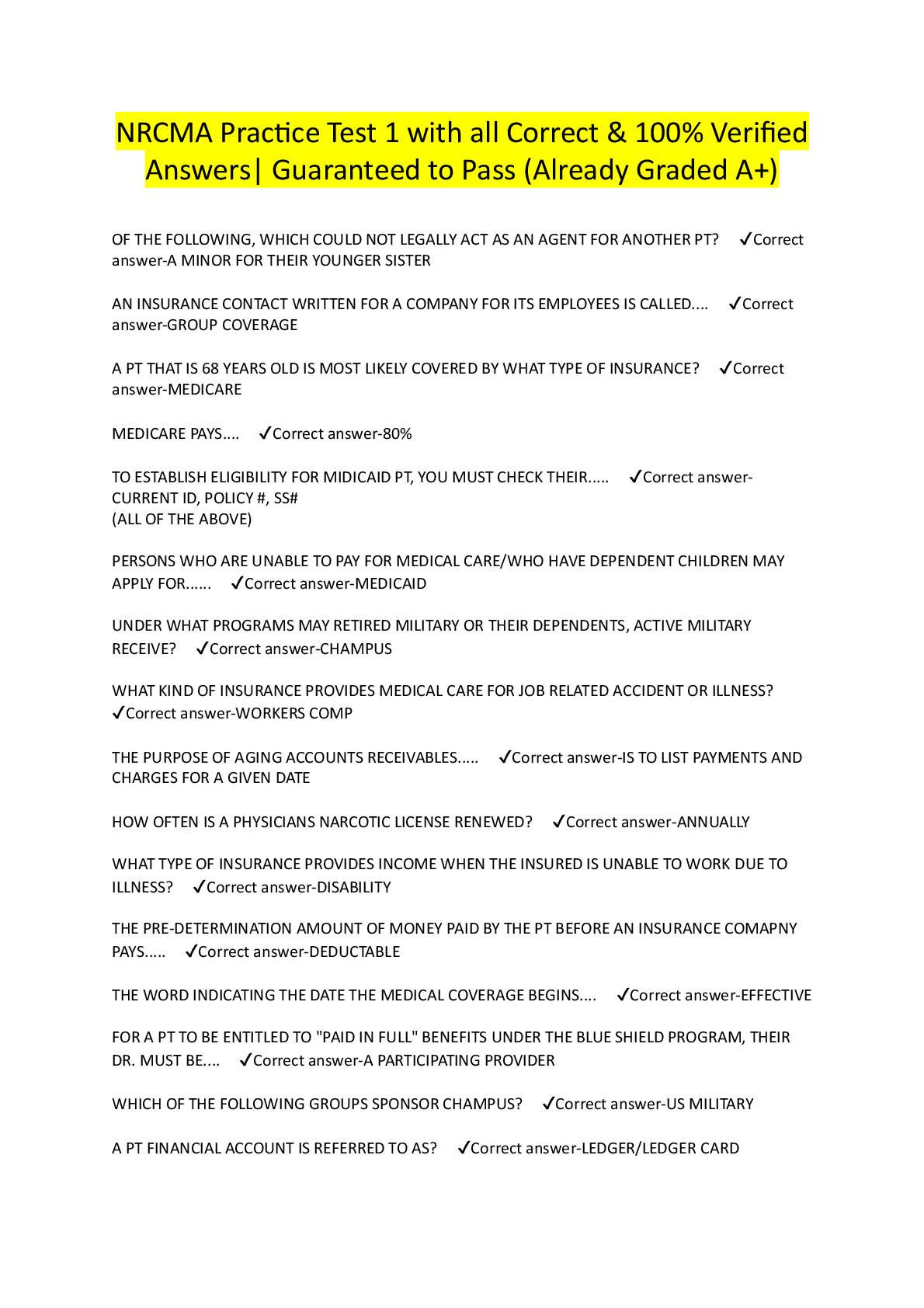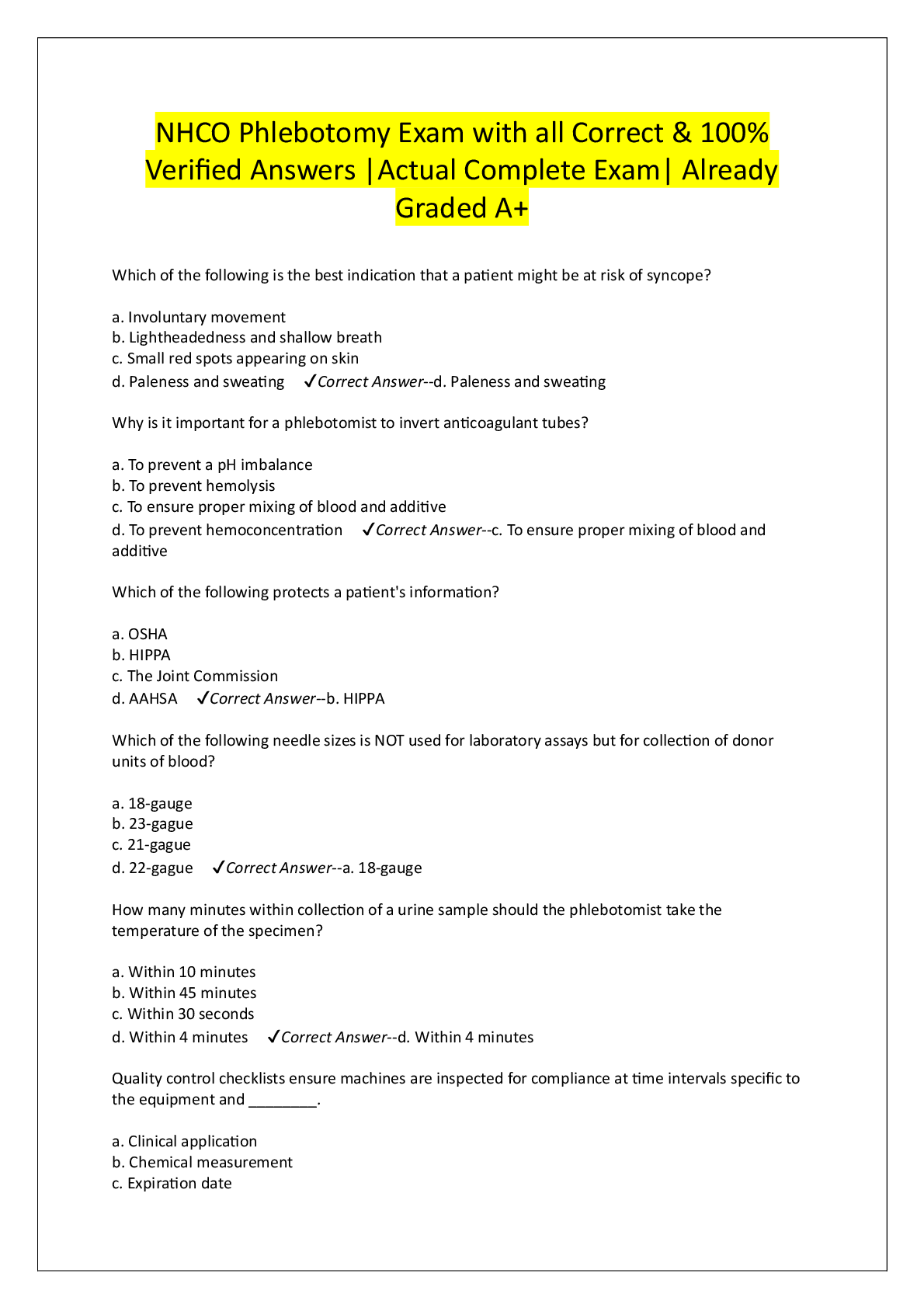WEEK 5 QUIZ (QUESTION 1 TO QUESTION 20)
Document Content and Description Below
WEEK 5 QUIZ (QUESTION 1 TO QUESTION 20). Question 1 Which medication classification is generally included in the treatment of silicosis? Student Answer: CORRECT Corticosteroids Antibiotics Bronch ... odilators Expectorants Instructor Explanation: No specific treatment exists for silicosis, although corticosteroids may produce some improvement in the early, more acute stages. The other options are not generally prescribed. Points Received: 0.5 of 0.5 Comments: Question 2 Which immunoglobulin is present in childhood asthma? Student Answer: Immunoglobulin M (IgM) Immunoglobulin G (IgG) CORRECT Immunoglobulin E (IgE) Immunoglobulin A (IgA) Instructor Explanation: Included in the long list of asthma-associated genes are those that code for increased levels of immune and inflammatory mediators (e.g., interleukin [IL]–4, IgE, leukotrienes), nitric oxide, and trans membrane proteins in the endoplasmic reticulum. None of the other options are associated with childhood asthma. Points Received: 0.5 of 0.5 Comments:Question 3 Sitting up in a forward-leaning position generally relieves which breathing disorder? Student Answer: Hyperpnea CORRECT Orthopnea Apnea Dyspnea on exertion Instructor Explanation: Of the options available, only orthopnea is generally relieved by sitting up in a forward-leaning posture or supporting the upper body on several pillows. Points Received: 0.5 of 0.5 Comments: Question 4 How does chest wall compliance in an infant differ from that in an adult? Student Answer: CORRECT An adult’s chest wall compliance is lower than an infant’s. INCORRECT An adult’s chest wall compliance is higher than an infant’s. An adult’s chest wall compliance is the same as an infant’s. An adult’s chest wall compliance is dissimilar to that of an infant’s. Instructor Explanation: Chest wall compliance is higher in infants than it is in adults, particularly in premature infants. Points Received: 0 of 0.5 Comments:Question 5. Which pulmonary defense mechanism propels a mucous blanket that entraps particles moving toward the oropharynx? Student Answer: Nasal turbinates Alveolar macrophages CORRECT Cilia Irritant receptors on the nares Instructor Explanation: The submucosal glands of the bronchial lining produce mucus, contributing to the mucous blanket that covers the bronchial epithelium. The ciliated epithelial cells rhythmically beat this mucous blanket toward the trachea and pharynx, where it can be swallowed or expectorated by coughing. This selection is the only option that accurately identifies the pulmonary defense mechanism described. Points Received: 0.5 of 0.5 Comments: Question 6. If a patient develops acidosis, the nurse would expect the oxyhemoglobin dissociation curve to react in which manner? Student Answer: CORRECT Shift to the right, causing more oxygen (O2) to be released to the cells Shift to the left, allowing less oxygen (O2) to be released to the cells Show no change, allowing the oxygen (O2) concentration to remain stable Show dramatic fluctuation, allowing the oxygen (O2) concentration to increase Instructor Explanation: A shift to the right depicts hemoglobin’s decreased affinity for O2 or an increase in the ease with which oxyhemoglobin dissociates and O2 moves into the cells. The oxyhemoglobin dissociation curve is shifted to the right by acidosis (low pH) and hypercapnia (increased partial pressure of arterial carbon dioxide [PaCO2]). This selection is the only option that accurately identifies what will happen to the oxyhemoglobin dissociation curve if acidosis occurs. Points Received: 0.5 of 0.5 Comments:Question 7. Which pleural abnormality involves a site of pleural rupture that acts as a one-way valve, permitting air to enter on inspiration but preventing its escape by closing during expiration? Student Answer: Spontaneous pneumothorax CORRECT Tension pneumothorax Open pneumothorax Secondary pneumothorax Instructor Explanation: In tension pneumothorax, the site of pleural rupture acts as a one-way valve, permitting air to enter on inspiration but preventing its escape by closing up during expiration. As more and more air enters the pleural space, air pressure in the pneumothorax begins to exceed barometric pressure. None of the other options result from the pathologic condition described. Points Received: 0.5 of 0.5 Comments: Question 8. Clinical manifestations of decreased exercise tolerance, wheezing, shortness of breath, and productive cough are indicative of which respiratory disorder? Student Answer: CORRECT Chronic bronchitis Emphysema Pneumonia INCORRECT Asthma Instructor Explanation: The symptoms that lead individuals with chronic bronchitis to seek medical care include decreased exercise tolerance, wheezing, and shortness of breath. Individuals usually have a productive cough (“smoker’s cough”). The described symptoms are not associated with any of the other options. Points Received: 0 of 0.5 Comments:Question 9. How is most carbon dioxide (CO2) in the blood transported? Student Answer: Attached to oxygen (O2) CORRECT In the form of bicarbonate Combined with albumin INCORRECT Dissolved in the plasma Instructor Explanation: Approximately 60% of the CO2 in venous blood and 90% of the CO2 in arterial blood are carried in the form of bicarbonate. Points Received: 0 of 0.5 Comments: Question 10 Kussmaul respirations as a respiratory pattern may be associated with which characteristic(s)? Student Answer: Alternating periods of deep and shallow breathing Pulmonary fibrosis COPD CORRECT Slightly increased ventilatory rate, large tidal volumes, and no expiratory pause Instructor Explanation: Kussmaul respirations are characterized by a slightly increased ventilatory rate, very large tidal volume, and no expiratory pause. Kussmaul respirations are not associated with any of the other options. Points Received: 0.5 of 0.5 Comments:Question 11 Why is nasal congestion a serious threat to young infants? Student Answer: CORRECT Infants are obligatory nose breathers. INCORRECT Infants’ noses are small in diameter. Infants become dehydrated when mouth-breathing. An infant’s epiglottis is proportionally bigger than the epiglottis of an adult’s. Instructor Explanation: Infants up to 2 to 3 months of age are obligatory nose breathers and are unable to breathe in through their mouths. Nasal congestion is therefore a serious threat to a young infant. This selection is the only option that accurately describes why nasal congestion is a serious threat to young infants. Points Received: 0 of 0.5 Comments: Question 12 In which type of pleural effusion does the fluid become watery and diffuse out of the capillaries as a result of increased blood pressure or decreased capillary oncotic pressure? Student Answer: Exudative Purulent CORRECT Transudative Large Instructor Explanation: In transudative pleural effusion, the fluid, or transudate, is watery and diffuses out of the capillaries as a result of disorders that increase intravascular hydrostatic pressure or decrease capillary oncotic pressure. The described mechanism is not associated with the other forms of pleural effusion. Points Received: 0.5 of 0.5 Comments:Question 13 Which option shows the correct sequence of events after atelectasis develops in RDS of the newborn? Student Answer: Increased pulmonary vascular resistance, atelectasis, and hypoperfusion CORRECT Hypoxic vasoconstriction, right-to-left shunt, and hypoperfusion Respiratory acidosis, hypoxemia, and hypercapnia INCORRECT Right-to-left shunt, hypoxic vasoconstriction, and hypoperfusion Instructor Explanation: Atelectasis results in a decrease in tidal volume, causing alveolar hypoventilation and hypercapnia. Hypoxia and hypercapnia cause pulmonary vasoconstriction, which increases intrapulmonary resistance and shunting. This results in hypoperfusion of the lung and a decrease in effective pulmonary blood flow. This selection is the only option that identifies the correct sequence of events. Points Received: 0 of 0.5 Comments: Question 14 Pulmonary artery hypertension (PAH) results from which alteration? Student Answer: CORRECT Narrowed pulmonary capillaries Narrowed bronchi and bronchioles Destruction of alveoli Ischemia of the myocardium Instructor Explanation: PAH is characterized by endothelial dysfunction with an overproduction of vasoconstrictors (e.g., thromboxane, endothelin) and decreased production of vasodilators (e.g., nitric oxide, prostacyclin), resulting in narrowed pulmonary capillaries. None of the remaining options result in pulmonary hypertension. Points Received: 0.5 of 0.5 Comments:Question 15 An increase in surface tension caused by decreased surfactant production results in which alteration? Student Answer: Decrease in alveolar macrophage production Increase in lung compliance INCORRECT Decrease in alveoli collapse CORRECT Increase in alveoli fluid collection Instructor Explanation: The decrease in surface tension caused by surfactant is also responsible for keeping the alveoli free of fluid. In the absence of surfactant, the surface tension tends to attract fluid into the alveoli. If surfactant production is disrupted or surfactant is not produced in adequate quantities, then the alveolar surface tension increases, causing alveolar collapse, decreased lung expansion, increased work of breathing, and severe gas-exchange abnormalities. The decrease in surface tension caused by surfactant is also responsible for keeping the alveoli free of fluid. The remaining options are not associated with decreased surfactant production. Points Received: 0 of 0.5 Comments: Question 16 Which term describes the pressure in the pleural space? Student Answer: Atmospheric CORRECT Below atmospheric Above atmospheric Variable Instructor Explanation: Pressure in the pleural space is usually negative or subatmospheric (–4 to –10 mm Hg). This selection is the only option that accurately describes pleural space pressure. Points Received: 0.5 of 0.5 Comments:Question 17 Which structure is not associated with any lymphatic vessels? Student Answer: INCORRECT Trachea Bronchi CORRECT Acinus Terminal bronchioles Instructor Explanation: No lymphatic structures are located in the acinus. The other options are associated with lymphatic vessels. Points Received: 0 of 0.5 Comments: Question 18 Which of the following is the primary problem resulting from RDS of the newborn? Student Answer: Consolidation Pulmonary edema CORRECT Atelectasis Bronchiolar plugging Instructor Explanation: The primary problem is atelectasis, which causes significant hypoxemia and is difficult for the neonate to overcome because a significant negative inspiratory pressure is required to open the alveoli with each breath. None of the other options are considered a primary problem associated with RDS. Points Received: 0.5 of 0.5 Comments:Question 19 The most successful treatment for chronic asthma begins with which action? Student Answer: CORRECT Avoidance of the causative agent Administration of broad-spectrum antibiotics Administration of drugs that reduce bronchospasm Administration of drugs that decrease airway inflammation Instructor Explanation: Chronic management of asthma begins with the avoidance of allergens and other triggers. The effectiveness of the other options is reliant on the avoidance of triggers. Points Received: 0.5 of 0.5 Comments: Question 20 Which statement is true regarding hypoxemia? Student Answer: Hypoxemia results in the increased oxygenation of arterial blood. CORRECT Respiratory alterations cause hypoxemia. Hypoxemia results in the decreased oxygenation of tissue cells. INCORRECT Various system changes cause hypoxemia. Instructor Explanation: Hypoxemia, or reduced oxygenation of arterial blood (PaO2), is caused by respiratory alterations, whereas hypoxia, or reduced oxygenation of cells in tissues, may be caused by alterations of other systems as well. Points Received: 0 of 0.5 Comments: [Show More]
Last updated: 3 years ago
Preview 1 out of 10 pages
.png)
Buy this document to get the full access instantly
Instant Download Access after purchase
Buy NowInstant download
We Accept:

Reviews( 0 )
$9.50
Can't find what you want? Try our AI powered Search
Document information
Connected school, study & course
About the document
Uploaded On
Jan 19, 2021
Number of pages
10
Written in
All
Additional information
This document has been written for:
Uploaded
Jan 19, 2021
Downloads
0
Views
93





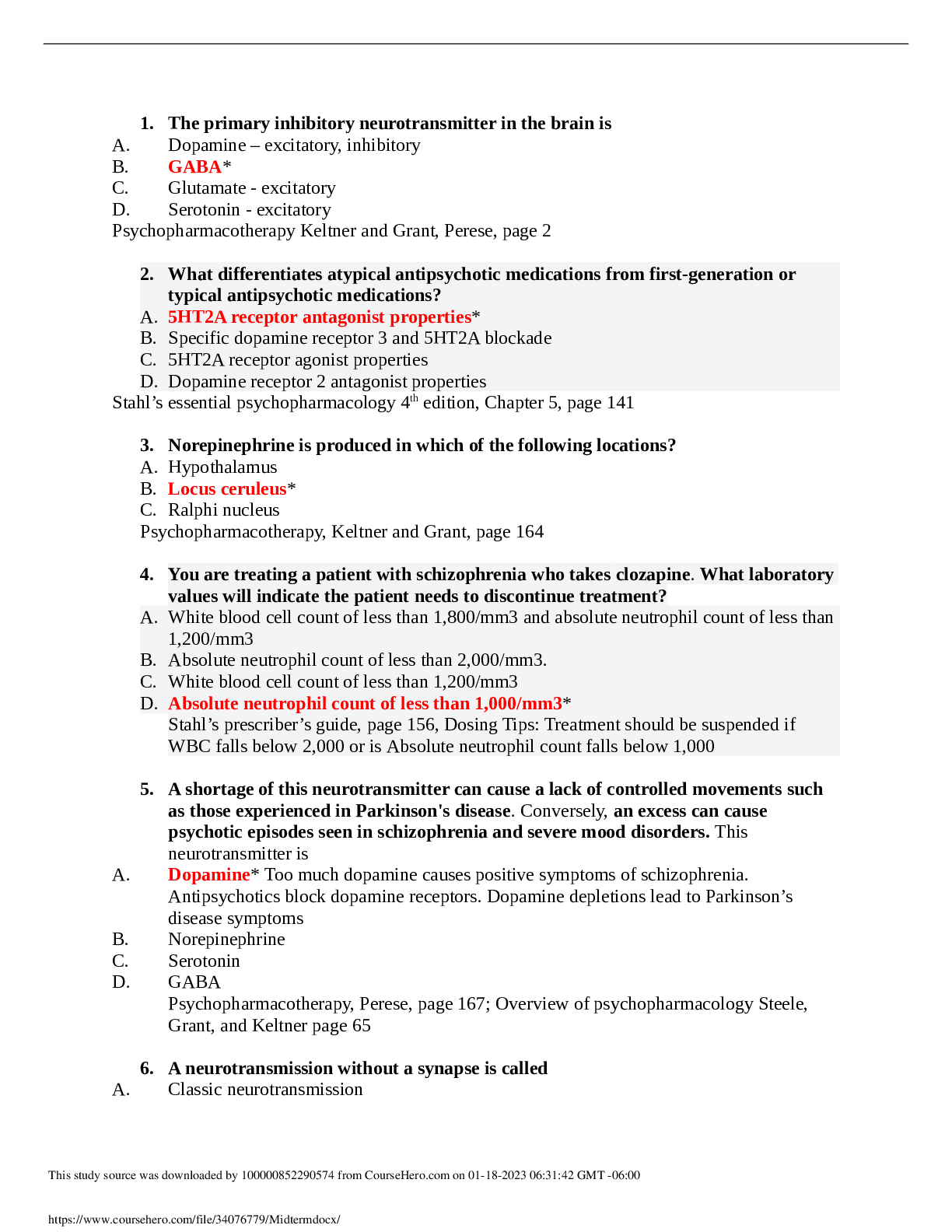
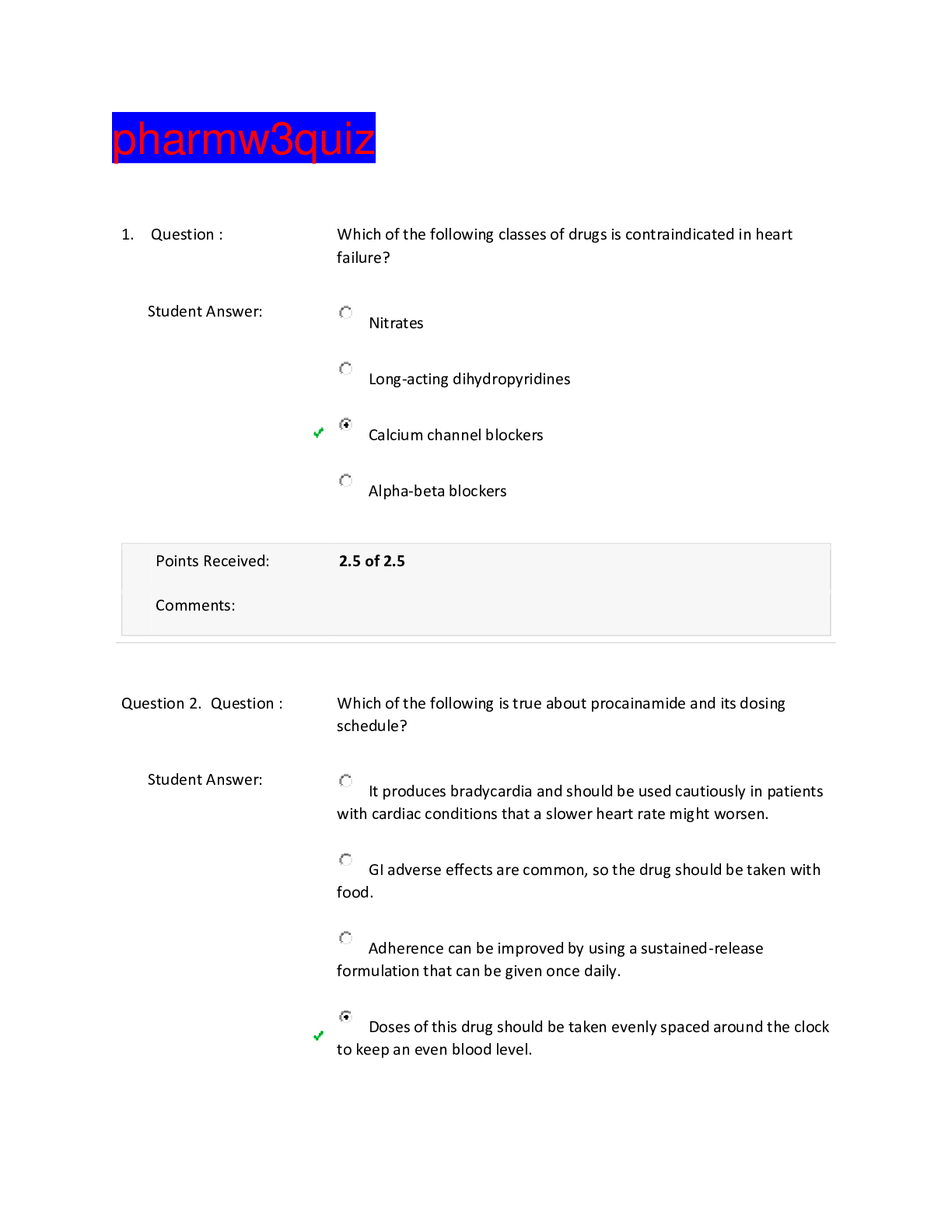
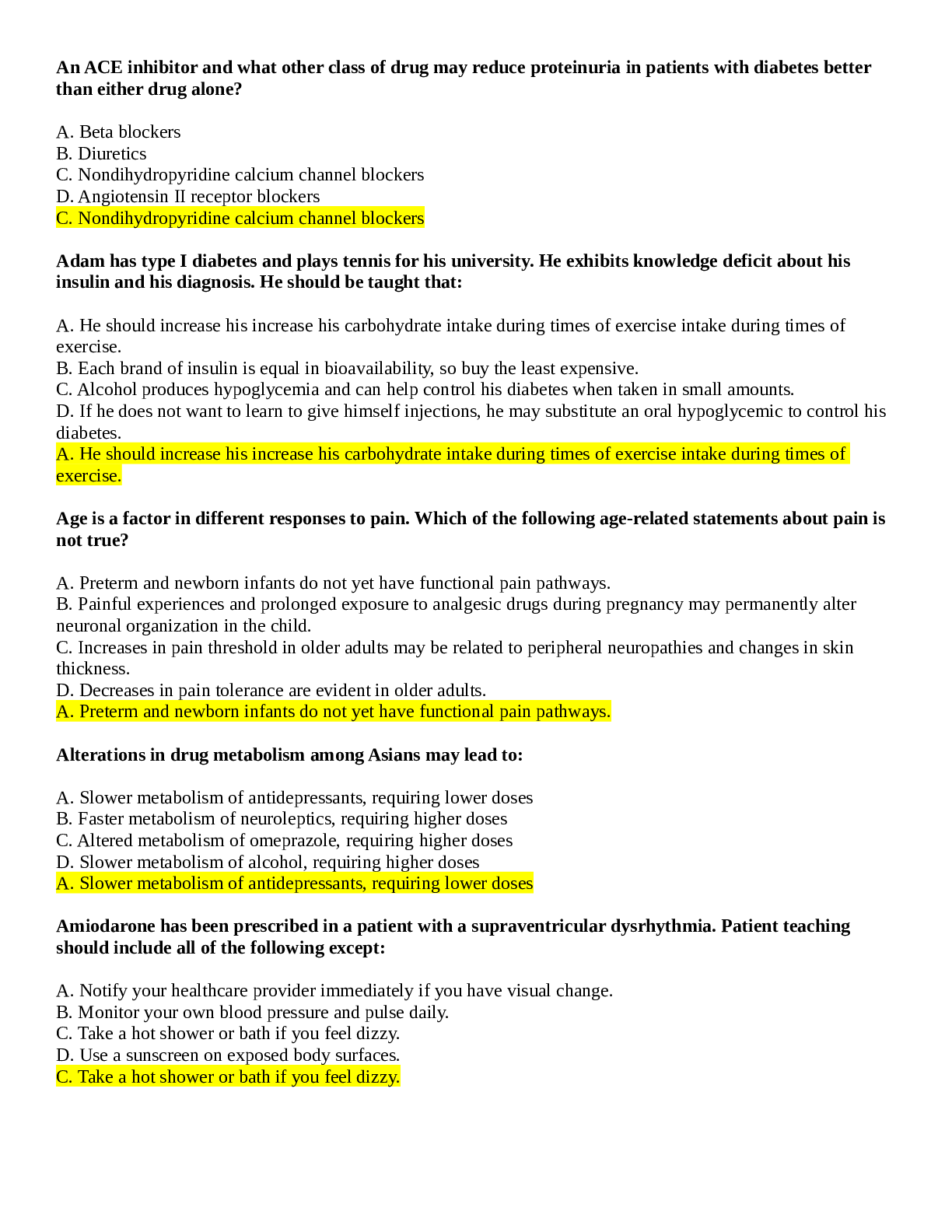
.png)
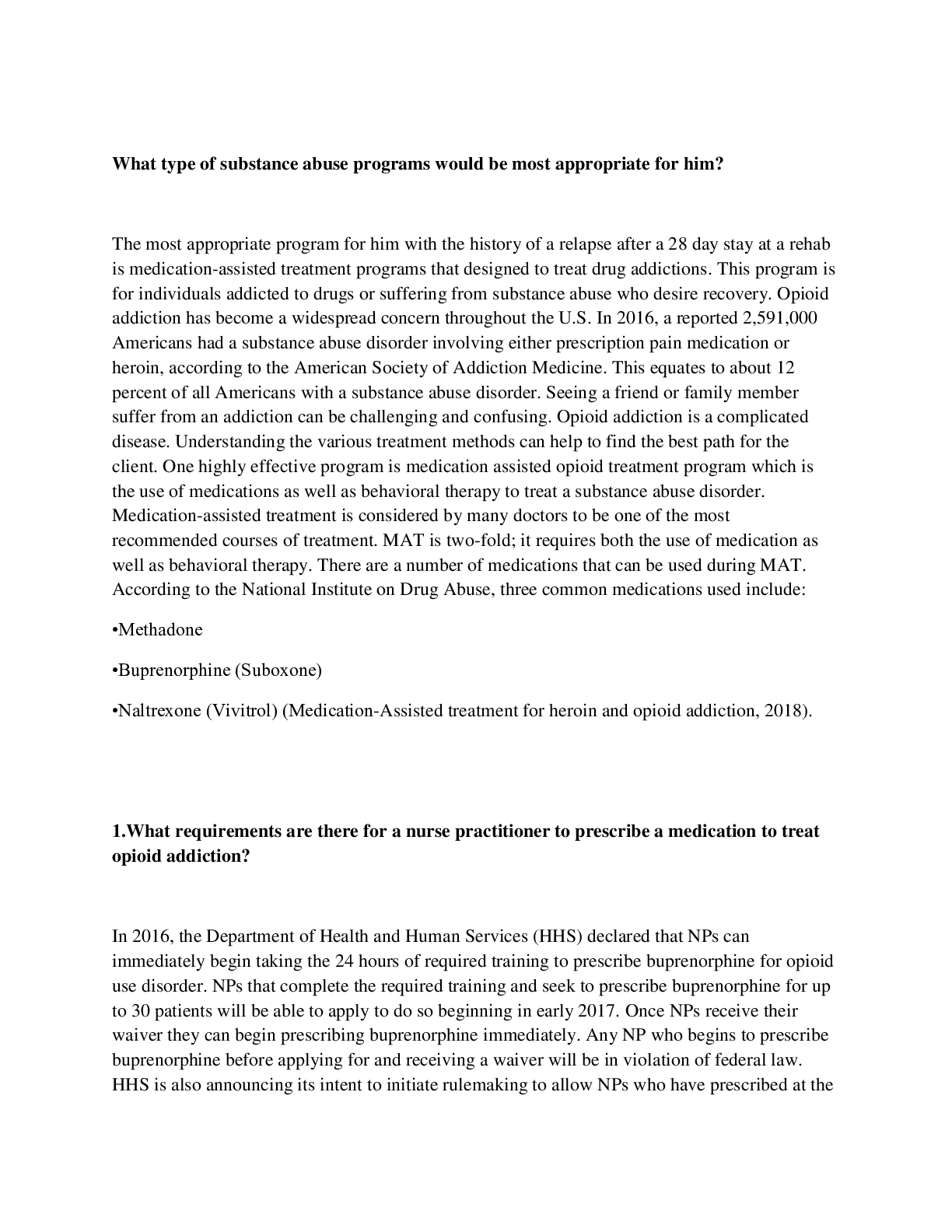
.png)

